Archives
September, 2012
Select a different month in the archive
Paternal Age and Autism Link Holds Up in Aruba
By Chelsea Toledo, M.A. on September 28, 2012
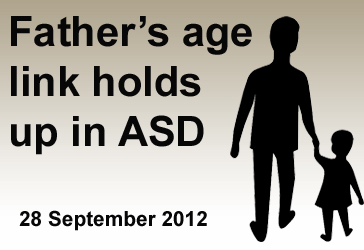
Background: Several major studies have demonstrated that children with Autism Spectrum Disorder (ASD) are more likely to be born to older fathers. However, the majority of that research has been carried out in high-income countries such as the United States, Western Australia and the United Kingdom. Research in less industrialized settings could shed light on the level to which social and cultural factors contribute to the prevalence of ASD within a geographical area.
What’s New: In the September 2012 version of PLOS ONE, researchers report that Aruban children with ASD are more than twice as likely to have been born to a father over age 30 than their peers without the disorder. Studying publically available medical records, they determined that the risk of having a child with ASD was about twice as high for fathers in their thirties and two and a half time as high for fathers in their forties than the risk for younger fathers. These findings are consistent with those from more industrialized nations and demonstrate that the link between paternal age and risk for ASD is present in a country with lower income, where the economy and demographics are in transition.
Why it’s important: While it is understood that the risk of having an autistic child increases with the age of the father, the explanation for that association is not yet clear. Because fathers in Aruba have diverse reasons for delayed parenting, the study effectively rules out the theory that men with unperceivable autism tend to have children later and pass on those genes.
Help me understand :
| Source(s) : |
| Tweet |
Drug Therapies Show Success for Fragile X Syndrome
By Stacy W. Kish on September 27, 2012

Background: Fragile X syndrome (FXS) is a common genetic cause of intellectual disability and autism. FXS individuals show a constellation of symptoms including intellectual disability, anxiety, epilepsy, attention deficits, hyperactivity and autistic behavior. FXS results from a silenced (turned off) FMR1 gene, which is associated with abnormal neural connections that impair synaptic connectivity.
What’s new: Researchers have conducted rigorous clinical trials using a drug-based therapy that targets a neurobiological pathway known to be altered in FXS. They have examined the effectiveness of STX209, a γ-aminobutyric acid type B (BAGAB) receptor agonist, in a mouse model and human trials. The therapy restored normal neurological connections leading to a reduction in protein synthesis, seizures, and repetitive behaviors in Fmr1-knockout mice in the study; this treatment showed little to no effect on the control mice in the study.
A concurrent study examined the effect of the same therapy on 63 subjects ranging from 6 to 39 years of age. The therapy improved social anxiety, as defined by the Aberrant Behavior Checklist-Social Avoidance scale. The therapy did not show significant success at treating aggression, self-injury, or irritability, as defined by the Aberrant Behavior Checklist (ABC-1).
Why it’s important: The new drug therapies show promise by targeting Fragile X syndrome at the molecular level by balancing neurotransmission. This intervention improved aspects of social behavior in Fragile X individuals with important consequences for autism
Help me understand :
| Source(s) : |
| Tweet |
Autism-Associated Genetic Variant Alters Brain Circuitry
By Eric Larsen, Ph.D. on September 21, 2012
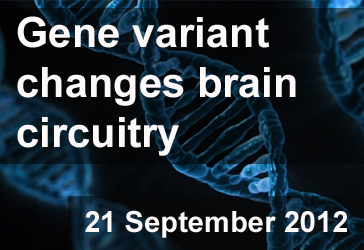
Background: Understanding how genetic variation leads to changes in brain circuitry underlying social behaviour is a critical issue in autism research. A common variant in the autism-linked gene known as MET has been identified as a genetic factor that may increase both the risk and severity of ASD. The autism-linked MET variant can be found in both unaffected individuals and people with Autism Spectrum Disorder (ASD).
What’s new: Researchers in Los Angeles, CA imaged the brains of 75 children and adolescents with ASD and 87 unaffected individuals, some of whom carry the risk variant of the MET gene, to determine if the presence of this risk variant affects brain circuitry. The researchers reported in the 6 September 2012 issue of Neuron that both unaffected individuals with the MET risk variant and those with ASD who harbor the same variation in the MET gene showed noticeable changes in how the brain responded to social stimuli. The researchers also identified abnormalities in brain connectivity, both in terms of function and structure. These effects were significantly more pronounced in individuals with ASD.
Why it’s important: The results of this study offer insight into how genetic variation affects brain circuitry in children with ASD as well as unaffected individuals. The circuitry changes caused by the MET risk variant can lead to an increased risk or increased severity of ASD.
Help me understand :
| Source(s) : |
| Tweet |
More Evidence for a Common Mechanism in Autism
By Stacy W. Kish on September 20, 2012
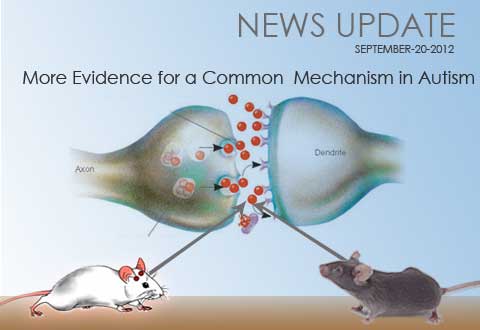
Background: Autism has been linked to hundreds of rare genetic mutations. Core symptoms of autism often accompany single-gene syndromes, like Fragile X. However, most autism cases do not meet the clinical diagnosis for a certain syndrome. These cases are referred to as nonsyndromic. Little is known about the similarity of biological mechanisms that underlie symptoms in syndromic and nonsyndromic forms of autism. One nonsyndromic form of autism under investigation is linked to a particular gene known as neuroligin-3 (NLGN3).
What’s new: Researchers used a mouse model to examine how the absence of NLGN3 affected cerebellum connectivity. The researchers found that NLGN3 is required for the proper function of particular postsynaptic receptors (mGluRs) during the wiring and communication of neurons known as Purkinje cells (a type of neuron important for motor coordination). Interestingly, problems in mice lacking NLGN3 are similar to those seen in mice harboring abnormalities in genes associated with Fragile X Syndrome (FMRI) and tuberous sclerosis complex (TSC2).
Why it’s important: The research suggests that some nonsyndromic and syndromic autism cases share similar abnormalities in how nerve cells project and communicate. By restoring NLGN3 gene function in juvenile mice, the researchers were able to repair Purkinje cell wiring. Drugs that have shown promise treating the underlying cause of autism symptoms in Fragile X may therefore provide new therapeutic options for some nonsyndromic autism cases as well.
Help me understand :
| Source(s) : |
| Tweet |
Autism Associated with Family Mental Health History
By Chelsea E. Toledo, M.A. on September 13, 2012
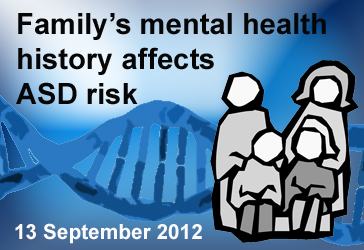
Background:
Until the 1980s, Autism Spectrum Disorder (ASD) was commonly diagnosed as childhood schizophrenia. Although ASD and schizophrenia are now regarded as distinct, common causal factors—such as genetic variations—can contribute to either condition, as well as to bipolar disorder.
What’s New:
In the 2 July 2012 online edition of the journal Archives of General Psychiatry, researchers report that ASD appears more frequently in people whose parents or siblings have been diagnosed with schizophrenia or bipolar disorder. The researchers studied over 30,000 medical records from Sweden and Israel and found that ASD was three times more likely to occur in people whose parents had a schizophrenia diagnosis. For people whose siblings had schizophrenia, ASD appeared 2.5 times more often in the Swedish group and 12 times more often in the group from Israel. In the entire sample, ASD was about twice as likely to occur when either a sibling or a parent was diagnosed with bipolar disorder.
Why it’s important:
The understanding of ASD’s cause remains incomplete. By studying factors that make ASD more common in some families than in others, researchers gain greater knowledge of the disorder’s etiology.
Help me understand :
| Source(s) : |
| Tweet |
Conditions Associated with Autism
By Stacy W. Kish on September 12, 2012
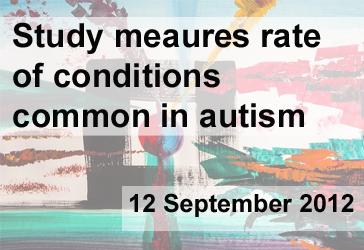
Background: Co-morbidity describes a series of conditions that are associated with an initial diagnosis. In the case of autism spectrum disorder (ASD), these conditions include sleep disorders, gastrointestinal complaints, epilepsy, cranial anomalies, muscular dystrophies, and other mental disorders. A recent study by Kohane and colleagues (2012) examined these conditions in children and young adults with ASD.
What’s new: The diagnoses of ASD has increased during the past 30 years, but most studies of co-morbid symptoms only include 200 or less patients. This study examined co-morbid condition in more than 14,000 individuals 35 years of age or younger.
The research team identified the prevalence of the following conditions in ASD individuals: epilepsy (19.4%), head anomalies (12.4%), bowel disorders (11.7%), schizophrenia (2.4%), sleeping disorders (1.1%), Down syndrome (0.9%), tuberous sclerosis (0.8%), inflammatory bowel disease (IBD) (0.8%), autoimmune disorders (DM1) (0.7%), and fragile X syndrome (0.5%). Only three of the conditions, schizophrenia, IBD, and DM1, increased with age of individuals in this study.
Why it’s important: Parents and health care professionals can use this information to better understand co-morbid conditions associated with ASD and watch for treatable symptoms.
Help me understand :
| Source(s) : |
| Tweet |
Rare Form of Autism Reversed in Mice
By Mark N. Ziats on September 11, 2012
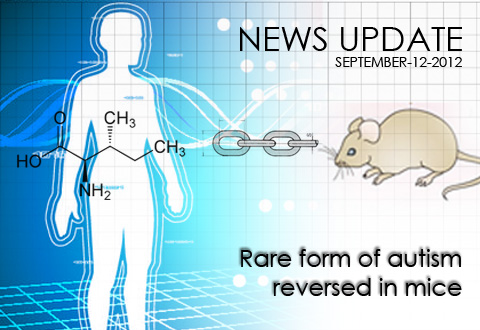
Background:
Many rare forms of autism result from specific variations in a patient’s DNA. The ability to sequence long stretches of DNA has dramatically improved over recent years. Researchers can now use DNA sequencing to read the genetic code of families affected with Autism Spectrum Disorder (ASD) to find mutations that may predispose children to the disease.
What’s New:
In the 6 September 2012 online edition of Science, researchers report a new genetic mutation linked to ASD in a gene that controls the metabolism of branched chain amino acids (BCAAs, a popular supplement among athletes!). Amino acids are important molecules that affect many functions in the body including brain activity. The researchers found lower levels of plasma BCAAs in individuals who carry the mutation in both copies of their chromosomes. Reasoning that amino acids are important for communication within the brain, the authors tested an amino acid supplementation diet in a mouse model that lacked the gene identified in the ASD individuals. The researchers report that neurological symptoms were reversed in the mice put on the diet.
Why it’s important:
While cases of autism caused by this specific mutation are likely to be extremely rare, this research provides some of the first evidence that the symptoms of autism are potentially reversible after their onset. This incredible finding is likely to spur further research into treatments that may improve autism symptoms in humans.
Help me understand :
| Source(s) : |
| Tweet |
FDA-Approved Cord Blood Trial Underway
By Shana R. Spindler, Ph.D. on September 10, 2012
Background:
Researchers have linked Autism Spectrum Disorder (ASD) to variations in hundreds of genes, but some children with autism do not carry any of these known genetic changes. A team of doctors from the Sutter Neuroscience Institute in Sacramento, California observed that cord blood infusions helped improve the condition of a young boy who developed Cerebral Palsy after being trapped in the birth canal for seven hours. The doctors hypothesized that cord blood stem cells, which can communicate with other cells in ways we do not fully understand, may help fix the underlying problem in children with ASD.
What’s New:
The United States Food and Drug Administration (FDA) has approved a clinical trial that will examine the use of cord blood stem cells in the treatment of ASD. Thirty children who have a form of autism with no known genetic cause will receive infusions of their own cord blood in a controlled pilot study. How the cord blood stem cells will target the underlying causes of autism remains unclear.
Why it’s important:
The environmental roots of autism are poorly understood, making treatment tricky. Through innovative clinical trials, we stand to gain important information about therapeutic strategies for autism with diverse etiology.
Help me understand :
| Source(s) : |
| Tweet |
Mouse Model Reveals Therapeutic Strategy
By Shana R. Spindler, Ph.D. on September 4, 2012

Background:
Dravet’s syndrome, a childhood disorder characterized by the onset of seizures within the first year of life, has symptoms common with Autism Spectrum Disorder (ASD) including—but not limited to—hyperactivity, stereotyped behaviors, inhibited social interactions, and marked cognitive deficits. Children with Dravet’s syndrome have a mutation in a string of DNA called the SCN1A gene. While most people have two copies of SCN1A, children with Dravet’s syndrome have only one functioning copy of the gene.
What’s New:
In the 22 August 2012 online edition of the journal Nature, researchers report that genetically engineered mice lacking one copy of SCN1A exhibit hyperactivity, anxiety, increased stereotyped behaviors, deficits in social interactions, and impaired cognitive function. According to the report, a specific type of neuron, called a GABAergic interneuron, requires two copies of SCN1A to hold back the transmission of electrical stimulation. When the researchers give the mice clonazepam, a type of drug known to help neurons block the spread of electric activity, the mice no longer exhibit impaired social behaviors and cognitive deficits.
Why it’s important:
Experiments with the mouse model of Dravet’s syndrome show that disruption of neuron inhibition may be one of the underlying causes of autism. Drugs that can restore the balance between inhibition and excitation of neurons are a potential therapeutic strategy for treating symptoms in some ASD-related syndromes.
Help me understand :
| Source(s) : |
| Tweet |

